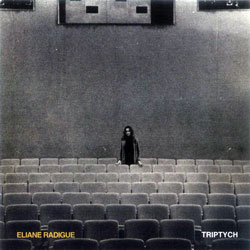
Three works created wholly on the ARP 2500 synthesizer in 1978, Triptych proffers yet another piece of the (archival) puzzle that informs the deft Ms. Radigue's vital body of work. A drone crone long before such terminology ran rampant in the journalistic marketplace, Radigue's music is a marvel of economic means, utterly unflinching in its unsaid maxim that less can truly be more. The pieces herein were originally commissioned for live dance (though one's imagination can grapple with how anyone could in any way gyrate to the gentle hum, curdle and swoosh on display) but remain standalone works on their own right, regardless of context.
Part One, as it were, sets the tone, neÚ the pace, quite effectively. Radigue notes that the works were inspired by the four elements (water, air, earth, and fire) and the fundamental feel is well established from the outset. From out of gentle, oscillating waves that sound more like ripples coursing through immense galaxies rather than anything terran-bound, arise low-grade hums and barely discernible tones that gradually deepen, broaden and widen. That wafting swoosh eventually becomes subsumed in the mass of the now strident tones that portray nothing less than the heartbeat of some great mechanical simulacra. The piece's beauty lies within its fiercely supple simplicity. Part Two is more of a resonating thing, the tones warbling up and down in pitch, as Radigue challenges the listener to have a look-see deep within her electronic devices. Like a string endlessly reverberating in a wind tunnel, the tone barely wavers, at times bent just enough to tickle the upper registers, but there is still much in the way of lateral progress; minimal the piece might be, but static it is not. Radigue, intentionally or otherwise, seemed to evoke nothing less than music from the spheres; the music's latent power is totally compelling.
The final work seems to arch straight out of a science fiction tableau, Radigue allowing those aforementioned warbles to perch and sing on varying levels, mimicking the whine of a flying saucer's engines dying while in orbit. Unearthly, phantasmagorical, this is music with little stylistic forebear or precedent, far outside the academic confines of a Bell Labs, INA-GRM, or other European sonic think tank. The fact that this was writ large way back in the stultifying musical climate that was the late 70s provides further heft to its relevancy for much of what is created today. To wit: this is pioneering synthesizer music of a mysterious kind, far-reaching, iconoclastic and essential in the extreme.
Comments and Feedback:
|



